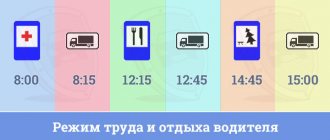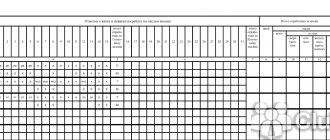Labor legislation establishes the standard working time - 40 hours per week. In my opinion, limiting working time and establishing its norm is a key achievement of civilization. Just remember how many upheavals, riots, and revolutions occurred precisely because of excess working hours!
What is the essence of working time? According to Art. 91 of the Labor Code of the Russian Federation, working time is the time during which an employee, in accordance with the internal labor regulations and the terms of the employment contract, must perform labor duties. ILO conventions describe this time to workers more categorically: this is the time during which the worker is at the disposal of the employer.
But doesn’t the current situation with working hours remind you of the plot of science fiction novels? When deviations from the norm were at first rare occurrences, then more frequent, and then it was difficult to meet the norm, because deviation from it sooner became the norm. So it is here. Non-standard working hours, non-standard ways of providing rest, unusual forms of employment, etc. are increasingly being used. Let's answer some common questions regarding non-standard working hours.
Working time as a legal category
The fundamental legal norm establishing the ratio of time spent on work and rest is Art.
37 of the Constitution of the Russian Federation, indicating that the employee, as a participant in labor relations, is guaranteed the maximum designated amount of time that he can use for work. It is regulated at the level of federal legislation and is limited by the legal provisions of the Labor Code of the Russian Federation. Art. 91 of the Labor Code defines the legal category “working time”. This is the time that an employee must use to perform a labor function, and the duration of this time, the start and end times are established by the employment contract. The Code, federal and industry regulations qualify the process of actual labor and “other” periods of time as working time. The category of other time intervals includes so-called regulated breaks:
- breaks related to the organization and technology of the labor process: for heating and rest according to Art. 109 of the Labor Code of the Russian Federation when performing a labor function not indoors or in an unheated room, for rest of air traffic controllers according to clause 11 of the regulations of the Ministry of Transport regulating the work of air traffic control (approved by order of the Ministry of Transport dated January 30, 2004 No. 10), for car drivers according to paragraphs. 15, 19 of the regulations of the Ministry of Transport regulating the work of car drivers (approved by order of the Ministry of Transport dated August 20, 2004 No. 15), etc.
- additional breaks for feeding children for working women when children are under 1.5 years of age under Art. 258 Labor Code of the Russian Federation.
The listed breaks are part of the working time and are subject to payment.
Normal working hours are no more than 40 hours
Normal working hours cannot exceed the limit specified by the code and is determined by (1) the amount of labor time expressed in hours, and (2) the calendar interval during which this number of hours must be worked. Art. 91 of the Labor Code of the Russian Federation regulates the first criterion (no more than 40 hours) and the second criterion - a time interval equal to a week. The norm is established in the general case, i.e. the performance of a labor function takes place under normal, standard conditions, and performers of labor duties do not require, for example, age, health or family status, special labor protection measures.
It should be noted that Art. 91 fixes the maximum limit for working time: the normal working time indicator cannot exceed 40 hours per week. This provision is generally applicable:
- for all employers, regardless of organizational and legal structure and form of ownership;
- for all types of labor contracts - open-ended, fixed-term, seasonal, short-term (the only exception is part-time work, where the duration of work is different in nature);
- for all employment schedules.
Special working time standards for special subjects
As already noted, the quantitative value of the working time norm depends on the properties of the subject of labor (worker) - his age, health - and, of course, on working conditions. The Labor Code provides a classification of types of working time by length. It could be:
- It is normal when the maximum duration for the general category of workers is no more than 40 hours in a work week (Article 91 of the Labor Code of the Russian Federation).
- Reduced, when the maximum duration is established for workers depending on age, health or existing harmful or dangerous working conditions. The maximums are regulated by Art. 92 of the Labor Code of the Russian Federation, and for various groups of workers the duration of the week is set at levels of no more than 36, 35, 24 hours. Note that there are industry standards that fix a different length of the working week for medical, teaching and other personnel.
- Incomplete when the duration is established by the employment agreement for employees with family responsibilities. Art. 93 names the circle of persons for whom the employer must, at their request, determine part-time work. These are pregnant women, parents of children under 14 years of age and other categories. It is understood that such employees are paid according to the hours worked.
Features of work on weekends/holidays
The Labor Code of the Russian Federation provides for two days off for workers of a five-day week and one day off for workers of six days. The second day off is determined upon concluding an employment contract. What they all have in common is Sunday.
As already mentioned, weekends can be postponed if they fall on non-working days. Whether weekends are postponed during holidays or not is decided by the employer, who provides certain working conditions and regimes.
The thing is that due to the specifics of certain productions, weekends cannot be postponed, as this is required for technical reasons. This practice is especially common in enterprises that cannot stop certain mechanisms or meet the population’s needs for water, electricity and other resources. For employees of such enterprises, days off are provided on any other days of the week in accordance with the internal queue and the order in which employees rest.
Weekends will not be postponed if they coincide with any January holidays: New Year holidays or Christmas. Two weekends in January are transferred by the Government to another regular calendar year.
Standard time for a schedule other than 5/2
So, the time of employment of an employee is limited by the legislator. The period defined as normal working hours cannot exceed a 40-hour week. Compliance with this legal provision is closely related to the solution of the question of how and according to what schedule the work is carried out.
The existing ratio of work and rest time has the following options: 5-day employment with 2 days of rest, 6-day work week with a single day off, a sliding schedule for providing days of rest, part-time work week. Let us note that the vast majority of workers work on a five-day basis (5 eight-hour working days per week).
It is necessary to dwell on some of the nuances of organizing work and rest time for other types of employment. For example, if a 6-day working week is established, then the length of the working day on the eve of a day off cannot exceed 5 hours (Article 95 of the Labor Code of the Russian Federation). In such circumstances, the legislator is not talking about a quantitative reduction in the size of the working week, but about the redistribution of working time in order to implement the norm of Art. 110 on the length of continuous rest time between working weeks of 42 hours. If a work schedule with “sliding” days off is established, then it is necessary to comply with the norm of Art. 111 about compulsory rest on Sunday.
Working hours are an essential working condition. For this reason, the employee’s employment schedule must be formalized by the employer in the form of a separate regulatory legal act or included in the internal regulations or collective agreement. If an employee’s employment regime differs from that adopted by the organization as a whole, it must be separately stated in the employment contract.
In addition to reflecting the length of the work week and daily work, the schedule must contain an hourly breakdown of the work day. As a result, the schedule should indicate the start and end times of work, established breaks, the number of shifts, the order of rotation of shifts, as well as the schedule of working days and weekends.
How to consolidate information regarding working hours
The normalized working day at the enterprise is fixed in the following order:
- The employer is looking for reasons why a particular scheme suits him best.
- Next, they determine which categories of employees and how they work during one day.
- The information is included in the local regulations associated with the company.
- A corresponding order is issued. The order is issued in relation to a specific employee, an entire group or the entire team. Changes can also be made to other local acts of the enterprise.
Normal working hours per week and standard working hours
So, Art. 91 of the Labor Code of the Russian Federation states: “ Normal working hours cannot exceed 40 hours per week.” This legal postulate has become fundamental in the methodology for calculating working hours.
Another document - order of the Ministry of Health and Social Development dated August 13, 2009 No. 588n - established a regulation according to which the duration of working hours is calculated in fixed calendar intervals and is based on a 5-day workweek schedule. The duration of work per day should be:
- 8 hours if the work week is 40 hours;
- if there are less than 40 working hours in a week, then the daily duration is established by dividing the number of hours of the working week by 5.
That is, the established length of the work week, which, as already noted, can be 40, 36, 35 or 24 hours, must be divided by 5 and multiplied by the number of working days in a certain month according to the five-day schedule. The resulting total should be reduced by the number of hours attributable to the reduction in labor time on the eve of non-working holidays. There is a standard established by Art. 95 Labor Code: on the days before non-working holidays, work hours should be reduced by 1 hour.
The method described above is convenient in that it can be used to calculate the standard working time, which is applicable in any employment mode.
The employer's responsibilities include personal and daily recording of each employee's work time.
For the form for recording working time and the procedure for filling it out, see the article “Working Time Sheet - Form T-13 (form).”
Working hours at night
If the employee’s duties require him to work in a period of time that is not biologically intended for this, from 10 p.m. to 6 a.m., then his shift (it would no longer be entirely correct to say “working day,” since this means night) should be 1 hour shorter than corresponding daily. The pay for such shifts is also increased.
REFERENCE! A night shift will be considered if at least half of its duration falls within the specified time period.
If an employee works on a short-time or part-time basis, his night shift will not be reduced.
When the obligation to work at night is fixed in the collective agreement, the reduction is also not made.
How to attract an employee to work at night ?
Working time tracking - we identify the norm and excess
Control over whether the duration of labor time complies with existing standards is carried out in the process of recording working time. The process of organizing labor at different enterprises can be organized on different principles. In particular, labor time can be recorded for various time periods, and, as a rule, enterprises choose from three options: day, week or summarized accounting.
Daily recording of working time is advisable for those employers whose work schedule assumes that the duration of work is the same on any day. In circumstances where the actual daily working hours exceed the standard, the difference is not compensated for by shortfalls in subsequent days, but is classified as overtime work.
Weekly recording of working hours is required in circumstances where, within the normal limits of weekly work, the length of working days may actually fluctuate from day to day. Weekly accounting is appropriate, for example, when work is carried out on a flexible schedule (Article 102 of the Labor Code of the Russian Federation).
Summarized accounting of working time is most necessary for such labor regimes as shift work (Article 103 of the Labor Code of the Russian Federation) or rotational work (Article 300 of the Labor Code of the Russian Federation). The principle of this type of accounting is as follows: the time of work is counted not as a week, but as another period (three weeks, a month, two months, etc.). The use of a different duration of interval for calculating working time is due to the fact that for objective reasons, for example due to the specifics of the enterprise, it is not possible to strictly adhere to the established, standardized duration of weekly or daily work. The time period taken by the employer for the purpose of standardization for calculating the number of working hours is called the accounting period. The total duration of work during this time cannot be more than the normal weekly, multiplied by the number of weeks. With all this, for the length of this period Art. 104 of the Labor Code of the Russian Federation defines a maximum of one year.
For more information on calculating the standard hours for a shift schedule, see the material “Normal hours for a shift work schedule according to the Labor Code.”
It is the employer's responsibility to record the time worked by employees. Moreover, it is necessary to take into account time both within the normal duration and in cases where working time standards are exceeded due to overtime work or work in irregular working hours. These two concepts characterize the employment of an employee in excess of the established norm and, therefore, require separate legal regulation.
Legal regulation of labor regulations
Chapter 15 of the Labor Code of the Russian Federation is fully devoted to the regulation of working time. It provides standards, limits depending on the category of employees, calculation and reporting of the organization. The law protects the rights of citizens, implementing the constitutional principle of a welfare state.
In particular, it establishes the maximum weekly work duration allowed in the Russian Federation. Usually it is divided by 5, according to the daily period. It is 8 hours or 40 hours per week. This is a basic provision that cannot be violated. If staff are forced to work more, they have the right to appeal to government agencies. The latter conduct an inspection, after which the company is obliged to bring its internal regulations into compliance with the current rules.
It is important to know! Sometimes the specified norm may be exceeded. Such situations are also reflected in the legislation, which provides for several working hours. We are talking about working above the norm, taking into account the characteristics of the enterprise, seasonal and regional specifics.
The federal government determines the calculation of the working period, distributing standards across time periods. This could be a month, a quarter, a year. The basic unit remains the week and the number of hours for the specified period. The management of the enterprise must keep records reflecting the time spent by employees performing their duties. Based on this, inspection organizations draw conclusions. The discrepancy between the information entered and the actual conditions becomes a reason for verification. Detected violations will result in penalties and sanctions.
Current regulations provide for:
- Five days. Employees work 5 days a week. As a rule, Saturday and Sunday are reserved for rest;
- Six days. In this case, only 1 day a week is a day off;
- Flexible schedule. Weekends are sliding, work can be carried out on the principle of 2/2, 3/3, etc. The number of hours usually exceeds 8, compensated by a large number of days off and their early onset.
In some industries, as well as for certain categories of employees, the rules may differ.
Legislative basis
Chapters 15 and 16 of the Labor Code and the Russian Federation are fully devoted to regulating the issue. In the 15th, general provisions are given, and in the 16th, the definition of working hours is indicated and acceptable options for the work schedule are given. The company's management is obliged to adhere to these standards; violation is fraught with intervention from regulatory authorities.
Basic provisions
In general, the law is quite flexible, leaving organizations room to maneuver. They can independently create a schedule for their activities, taking into account the working day according to the Labor Code. One of the basic rules remains the limit of 40 weekly hours or 8 hours every day. This is the optimal norm adopted in most countries pursuing social policies and caring for the population.
The specified duration allows organizations to solve problems and employees to cope with responsibilities, leaving them time to rest. Its minimum limit is 42 hours per week, starting from the end of the working day on Friday. Sometimes this may be a different day if the company has staggered holidays. The rules allow such a schedule.
Working time is considered to include both the direct performance by personnel of the functions assigned to them and preparation for the process. This is especially important with shifts and irregular schedules, when a piece-rate form of payment is used. That is, the company is obliged to pay not only for the result, but also for the preparatory actions. All of them are included in working hours, as well as a medical examination.
In this case, the journey to and from work is not included in the specified period and is not paid, as well as a lunch break and time spent changing clothes. When drawing up a schedule, several types of working hours and daily routines must be taken into account. This is done taking into account the interests of certain categories of employees whose rights are protected by law.
Regardless of whether an employee belongs to them, the management of the organization as a whole is obliged to establish a regime that ensures productive work and proper rest. First of all, this is a break between shifts and weekly days off. Usually the accepted standards reflect the agreement of the parties.
Existing types of working time
There are several ways to organize a working period. It is customary to highlight:
- Standard duration. This is a basic 40 hours per week or 8 hour work day;
- Partial day. Established at the request of an employee belonging to a certain category of citizens: disabled people, minors, pregnant women. As an option, part-time is initially specified in the agreement. Payment is proportional to the period worked or the volume of tasks (in the case of piecework);
- Daily work. In this case, the employee’s time at production is 24 hours, and he has the right to increased pay;
- Short format. It is also provided for certain categories of employees. The difference is the duration is less than 40 hours per week;
- Working overtime. They may be called upon occasionally, but only if this form is specified in the agreement of the parties. Management issues a written order; employee consent is not required;
- Irregular day. It is applied taking into account seasonal, regional and immediate specifics on site. Regardless of the reasons, higher rates apply.
It is important to know! In some cases, the norm is reduced by professional specifics. For example, drivers are required to periodically rest with warm-up exercises. Ignoring or violating the prescribed standards by the company allows employees to appeal to government agencies and the court.
Legal working hours
The norm is prescribed in Article 91 of the Labor Code of the Russian Federation, where it is specified as the actual period worked by the employee per day or other time period. Accordingly, when asking how long a person must work under the Labor Code, it is necessary to take into account this and other provisions.
There is no single standard (excluding the 40-hour weekly limit), since there are several categories of workers who may qualify for relief. Some are prohibited from working at night, others are given more time to rest, etc. All this is connected with the need to provide the citizen with proper rest, excluding physical and psychological overload.
For example, a minor employee cannot work more than:
- 4 hours if he is 14 years old;
- 5 hours if he is 15 years old;
- 7 hours if he is 16-18 years old.
If the work is carried out in parallel with training, the shift will be 2.5 hours for 14-16 year olds and 4 hours for 16-18 year olds.
Similar concessions are provided for citizens with health problems, namely confirmed disabilities. Specific numbers depend on the type and degree of the disease, but in any case, a disabled person has the right to request a part-time day. In addition, restrictions are imposed on certain types of work, such as carrying heavy objects.
When indicating how long a working day is under the Labor Code, the law takes into account individual professions and areas of activity related to the performance of life-threatening work. They are limited to 30 hours per week; an increase to 8 hours per day is allowed only with the consent of the citizen.
Advice! A pregnant woman and employees caring for a child with a disability have the right to work part-time. The number of hours is established by agreement of the parties. If there are circumstances (a person’s relationship to a specific category), management has no right to refuse.
A time limit is provided for citizens carrying out part-time work. It is 4 hours for additional work. If a person loses their main job, they can go full-time.
As for payment, it is made for the time actually worked or the volume completed (in the case of piecework). A reduced rate cannot be applied, this is discrimination. A reduced working day according to the Labor Code does not deprive a person of the right to vacation and other benefits.
Exceeding the norm: overtime and irregular working hours
Art. 99 of the Labor Code qualifies overtime work as work performed on the direct instructions of the employer outside the normal working hours. If we are talking about daily accounting, then such work will be considered work after the end of the working day or shift. If we are talking about summarized accounting, then such work is considered to be work that lasts more than the standard number of hours during the accounting period.
One of the mandatory conditions is that the employer’s instructions to work overtime must be in writing. Overtime work may be required subject to certain restrictions. The permissible limits depend on the type of work that must be performed overtime, the categories of workers involved, and finally, on the duration of overtime work.
Employee consent to overtime work is required to solve the following problems:
- to complete the work begun, which for objective reasons was not completed during the working day, provided that failure to complete this work will result in irreversible damage to property and create a threat to the life and health of people;
- to carry out repair work when a malfunction prevents the further work of a large number of workers;
- to replace a replacement worker who did not show up.
There are reasons why employees may be required to work overtime without their consent. These reasons are related to the need for action to prevent disasters or to carry out work to normalize the functioning of life support systems for the population during liquidation of the consequences of emergency situations.
In other cases, overtime work is possible with the consent of the employee, taking into account the opinion of the trade union organization. However, the procedure for taking into account the opinion of the trade union organization is not explained by the code (Article 371 of the Labor Code of the Russian Federation), and in practice, it is enough for the employer to notify the trade union (if there is one) of its decision related to overtime work.
The law prohibits overtime work for pregnant women and adolescents under 18 years of age. If there is consent and there are no medical contraindications, then it is allowed to involve women with children under 3 years of age and disabled people in work beyond the normal length. However, in such circumstances, a special licensing procedure applies: the specified employees confirm in writing that they are aware of their legal right not to work overtime.
The amount of overtime work for its performer should not exceed 4 hours for 2 consecutive days and for 120 hours per year. Overtime work should be paid in an increased amount (Article 152 of the Labor Code of the Russian Federation).
An irregular working day is considered to be a work schedule in which the duration of working hours differs significantly from the duration of work established by legislative acts. With such a schedule, workers may sometimes be required to work outside the normal working hours. The presence of an irregular working day is an essential condition of the labor function, and therefore it must be necessarily reflected in the employment agreement.
What does a working day include?
All regulation and standardization is carried out in accordance with labor legislation, which unambiguously defines what includes working time and what does not. If there is downtime at work that is not the fault of the employee, lunch time comes and the employee needs to go away to warm up in harsh conditions, then such time is also called working time. During these periods, a person can be directly at the workplace, but not perform direct duties. When working on a weekend or non-working day, a person must receive increased overtime pay.
Working on rest days is prohibited, but there are exceptions related to the specifics of production and the concluded contract. An employee may work a shift provided that this is compensated by increased pay and available time off at other times.
Results
The weekly working hours should not exceed the maximum of 40 hours determined by the legislator.
It is on the basis of this indicator that the standard working time is established for all available labor modes. Performing labor beyond the norm is subject to separate regulation by law. You can find more complete information on the topic in ConsultantPlus. Free trial access to the system for 2 days.









